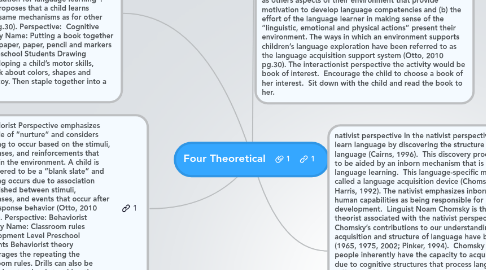Four Theoretical
by Silvia Aguilar

1. Behaviorist Perspective emphasizes the role of “nurture” and considers learning to occur based on the stimuli, responses, and reinforcements that occur in the environment. A child is considered to be a “blank slate” and learning occurs due to association established between stimuli, responses, and events that occur after the response behavior (Otto, 2010 pg.31). Perspective: Behaviorist Activity Name: Classroom rules Development Level Preschool Students Behaviorist theory encourages the repeating the classroom rules. Drills can also be used when teacher is teaching the behavior to act as reinforcement of the behavior.
2. Cognitive Developmental PerspectivePerspective is based in the work of Jean Piaget. The emphasis of this perspective is that language is acquired as maturation occurs and cognitive competencies develop. Whereas the nativist perspective emphasizes the inborn language mechanism, the cognitive developmental perspective assumes that cognitive development is a “prerequisite and foundation for language learning”. This perspective also proposes that a child learns language by using the same mechanisms as for other learning (Otto, 2010 pg.30). Perspective: Cognitive Developmental Activity Name: Putting a book together Materials construction paper, paper, pencil and markers Development Level Preschool Students Drawing everyday besides developing a child’s motor skills, drawing make him think about colors, shapes and drawing their favorite toy. Then staple together into a book.
3. nativist perspective In the nativist perspective, children learn language by discovering the structure of their language (Cairns, 1996). This discovery process is thought to be aided by an inborn mechanism that is specific for language learning. This language-specific mechanism is called a language acquisition device (Chomsky, 1982; Harris, 1992). The nativist emphasizes inborn or innate human capabilities as being responsible for language development. Linguist Noam Chomsky is the major theorist associated with the nativist perspective. Chomsky’s contributions to our understanding of the acquisition and structure of language have been significant (1965, 1975, 2002; Pinker, 1994). Chomsky contends that all people inherently have the capacity to acquire language due to cognitive structures that process language differently from other stimuli. Chomsky proposes that this universal grammar is an innate property of the human mind. Building on Chomsky’s work, Steven Pinker (1994) contended that language is an instinct. Because language exists in every culture, Pinker concluded that t must come from human biological instinct rather than from the existence of the culture (Otto, 2010 pg.30). The nativist perspective and the activity is the book, Brown Bear. I would begin by reading the book to the children. The following day I would do the flannel story of the same book. Children will learn the structure of language.
4. interactionist perspectiveThe interactionist perspective focuses on the primary role of sociocultural interaction in children’s development of language knowledge (Bruner, 1983, 1990; John-Steiner Panofsky, & Smith, 1994; Schieffelin & Ochs, 1986). This perspective contends that children acquire language through their attempts to communicate with the world around them. Another aspect of the interactionist perspective is it focuses on the language development process rather than on language as a product of development. Extensive research conducted by Bloom and Tinker (2001) has further added to the interactionist perspective. In their study of young children between the ages of 9 months and 2 years, Bloom and Tinker found that children expanded considerable effort in acquiring language. Bloom and Tinker propose the Intentionality Model of language development, which has two components: (a) active engagement with others as well as others aspects of their environment that provide motivation to develop language competencies and (b) the effort of the language learner in making sense of the “linguistic, emotional and physical actions” present their environment. The ways in which an environment supports children’s language exploration have been referred to as the language acquisition support system (Otto, 2010 pg.30). The interactionist perspective the activity would be book of interest. Encourage the child to choose a book of her interest. Sit down with the child and read the book to her.


